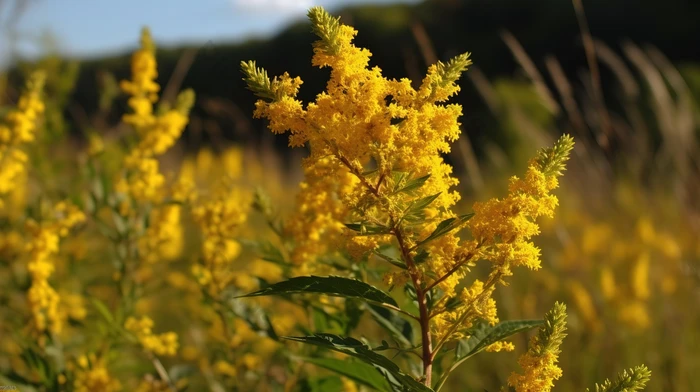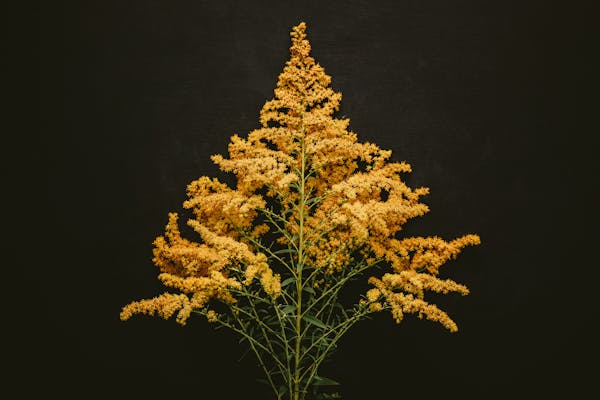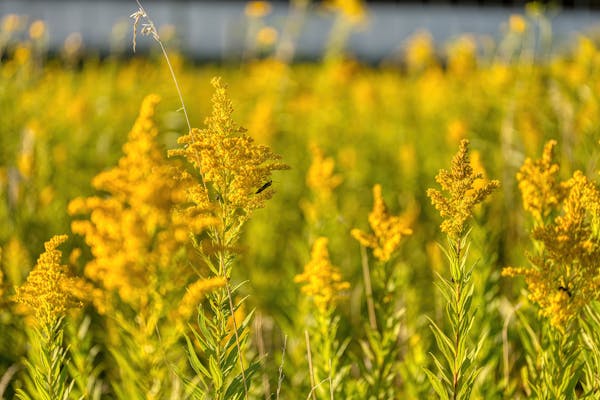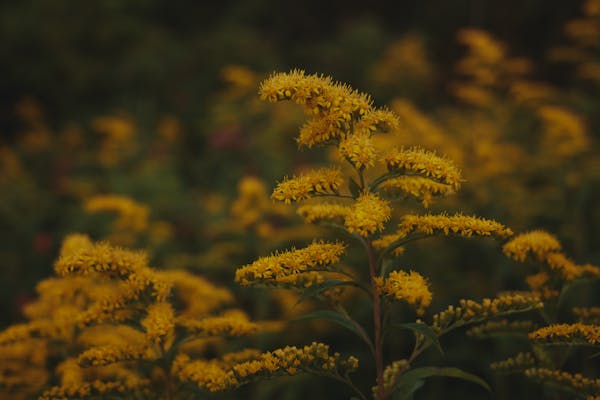“How To Care For Goldenrod: Tips For New Gardeners”

Introduction
Goldenrod is one of North America’s most misunderstood native plants. Often blamed for seasonal allergies and dismissed as a roadside weed. This plant deserves a place of honor in our gardens and natural medicine cabinets.
Here are some fascinating quick facts about this plant:
- Native Range: Found in all 48 contiguous United States
- Blooming Season: Late summer to early fall
- Height: Usually 2-5 feet, though some species can reach 7 feet
- Pollinator Value: Supports over 100 native bee species
- Species Count: More than 100 different goldenrod species in North America
What Is Goldenrod?
Scientific Classification
Goldenrod, known as Solidago, belongs to the vast Asteraceae family. The family includes familiar plants like sunflowers and daisies. The genus name “Solidago” comes from the Latin words “solidus” and “ago”. The name means “to make whole” or “to heal,” reflecting its long history of medicinal use.
Natural Habitat and Distribution
Associated with North America, goldenrod species are found across:
- North America: Greatest diversity with over 100 species
- Europe: Both native and introduced species
- Asia: Several native species, particularly in China
- South America: Limited distribution of specific varieties
Goldenrod thrives in various environments, including:
- Meadows and prairies
- Forest edges
- Coastal areas
- Mountain regions
- Urban environments
Physical Characteristics
The distinctive features of goldenrod make it recognizable:
Height and Structure:
- Main stem: Unbranched until the flower cluster
- Growth pattern: Upright and sturdy
- Texture: Stems are often reddish or purple-tinged
- Branch formation: Alternating pattern along the stem
Leaf Patterns:
- Shape: Lance-shaped to elliptical
- Arrangement: Alternate along the stem
- Edges: Usually toothed
- Surface: Smooth to slightly hairy
- Color: Deep green to blue-green
Flower Clusters:
- Formation: Pyramid-shaped or flat-topped panicles
- Color: Brilliant golden yellow
- Size: Individual flowers are tiny, but clustered in impressive displays
- Bloom structure: Each flower head contains both ray and disk flowers
- Pollen: Sticky and heavy, carried by insects rather than wind
Blooming Season and Lifecycle
- Spring: New growth emerges from underground rhizomes
- Summer: Plants develop strong stems and full foliage
- Late Summer: Flower buds begin to form
- Fall: Peak blooming period, lasting 4-6 weeks
- Winter: Seeds disperse, plants die back to ground level
Debunking Common Myths About Goldenrod
The Allergy Myth: Setting the Record Straight
The most pervasive myth about goldenrod is that it causes seasonal allergies. Here’s why this is incorrect:
- Pollen Structure: Goldenrod pollen is:
- Heavy and sticky
- Designed for insect pollination
- Unable to travel far on wind currents
- Too large to be a significant allergen
- Scientific Evidence: Studies have shown that goldenrod pollen rarely causes allergic reactions because:
- It doesn’t become airborne easily
- The pollen grains are too large to enter human nasal passages easily
- Less than 1% of allergy sufferers react to goldenrod in controlled tests
Goldenrod vs. Ragweed: The Real Culprit
The true source of fall allergies is often ragweed. It blooms at the same time as a goldenrod. Here’s how to tell them apart:
Goldenrod (Solidago):
- Bright yellow, showy flowers
- Grows 2-7 feet tall
- Flowers cluster in plumes
- Sticky, heavy pollen
- Attracts many pollinators
Ragweed (Ambrosia):
- Small, green, inconspicuous flowers
- Usually 1-4 feet tall
- Flowers in spikes
- Light, wind-blown pollen
- Few insect visitors

Benefits and Uses of Goldenrod
Medicinal Properties
Goldenrod’s therapeutic potential has been known for centuries.
Traditional Medicinal Uses
Ancient healers used goldenrod for:
- Wound healing
- Kidney support
- Respiratory health
- Digestive issues
- Pain relief
Modern Research Findings
Scientific studies have identified several beneficial compounds in goldenrod:
Active Compounds:
- Flavonoids
- Saponins
- Essential oils
- Tannins
- Polysaccharides
Therapeutic Applications:
- Urinary Tract Health
- Natural diuretic properties
- Anti-inflammatory effects
- Antimicrobial activity
- Kidney stone prevention
- Anti-inflammatory Benefits
- Reduces joint pain
- Helps with muscle soreness
- Supports tissue recovery
- May help with arthritis symptoms
- Immune System Support
- Antioxidant properties
- Antimicrobial effects
- Respiratory system support
- Seasonal wellness support
Garden Benefits
Supporting Pollinators
Goldenrod serves as a late-season food source for many pollinators:
- Bees:
- Supports over 100 native bee species
- Provides essential late-season pollen
- Attracts honey bees and bumble bees
- Helps bees prepare for winter
- Butterflies:
- Attracts monarch butterflies during migration
- Supports various swallowtail species
- Provides nectar for smaller butterflies
- Hosts several butterfly larvae species
Attracting Beneficial Insects
Goldenrod attracts helpful insects that protect your garden:
- Predatory Insects:
- Lady beetles
- Praying mantises
- Assassin bugs
- Parasitic wasps
- Garden Defenders:
- These beneficial insects help control:
- Aphids
- Spider mites
- Caterpillars
- Other garden pests
- These beneficial insects help control:
Soil Stabilization
Goldenrod’s root system provides soil support:
- Root Structure:
- Deep, fibrous roots
- Extensive horizontal rhizomes
- Dense root mass
- Excellent erosion control
- Soil Benefits:
- Prevents soil erosion
- Improves soil structure
- Increases organic matter
- Enhances water retention

Other Uses
Natural Dye Making
Goldenrod produces natural dyes:
- Colors Produced:
- Yellow (from flowers)
- Green (from leaves)
- Tan (from stems)
- Bronze (combined with modifiers)
- Dyeing Applications:
- Wool and other natural fibers
- Paper and art materials
- Natural fabric dyes
- Historical reenactment materials
Tea Preparation
Goldenrod makes a flavorful and healthful tea:
Preparation Methods:
- Fresh flower tea
- Dried leaf tea
- Combined herb blends
- Cold-brewed preparations
Health Benefits of Goldenrod Tea:
- Supports kidney function
- Aids digestion
- Reduces inflammation
- Boosts immune system
Historical Uses by Native Americans
Native American tribes found many uses for goldenrod:
Medicinal Applications:
- Throat ailments
- Fever reduction
- Wound healing
- Pain relief
Practical Uses:
- Basket weaving
- Smoking mixtures
- Chewing gum
- Natural dyes
Growing Goldenrod
Growing Goldenrod starts with planning and understanding its needs.
Garden Planning
Best Locations for Planting
Choose a planting location based on these key factors:
Ideal Settings:
- Sunny meadow gardens
- Perennial borders
- Wildlife gardens
- Rain gardens
- Natural areas
Space Considerations:
- Allow 2-3 feet between plants
- Plan for mature height (2-7 feet)
- Consider spread potential
- Account for neighboring plants
Soil Requirements
Goldenrod adapts to various soil conditions:
- Soil Types:
- Well-draining loam
- Clay-loam mixtures
- Sandy soils
- Average garden soil
- Soil Characteristics:
- pH range: 5.5-7.5
- Moderate fertility
- Good drainage
- Organic matter content: 3-5%
Sunlight Needs
For optimal growth, provide:
- Full sun (6+ hours daily)
- Partial sun in hot climates
- Morning sun exposure
- Protection from intense afternoon sun
Planting Guide
When to Plant
Spring Planting:
- After last frost
- Soil temperature above 60°F
- Ground workable
- Regular rainfall pattern
Fall Planting:
- 6 weeks before the first frost
- Soil still warm
- Adequate moisture
- Time to establish roots
Spacing Requirements
- Between Plants:
- Small species: 18-24 inches
- Medium species: 24-36 inches
- Large species: 36-48 inches
- Row Spacing:
- Garden beds: 3-4 feet
- Naturalized areas: 2-3 feet
- Mass plantings: 2 feet
Propagation Methods
- Seeds:
- Collect in late fall
- Cold stratify for 3 months
- Surface sow in spring
- Keep soil moist
- Germination in 14-21 days
- Division:
- Best done in early spring
- Divide every 3-4 years
- Use sharp, clean tools
- Keep roots moist
- Replant immediately
- Cuttings:
- Take 4-6 inch stem cuttings
- Remove lower leaves
- Dip in rooting hormone
- Plant in a moist medium
- Maintain high humidity

Care and Maintenance
For vibrant goldenrod plants that enhance your garden.
Watering Needs
New Plants:
- Water after planting
- Keep soil moist
- Water every 2-3 days
- Check soil moisture
- Adjust for rainfall
Established Plants:
- Drought tolerant
- Water during extended dry spells
- Deep watering when needed
- Morning watering preferred
- Allow soil to dry between waterings
Fertilization
Annual Schedule:
- Early spring: Light compost application
- Mid-season: None usually needed
- Fall: No fertilization required
Natural Fertilization Methods:
- Compost mulch
- Leaf mold
- Aged manure
- Worm castings
Pruning Techniques
Maintain plant health and appearance through proper pruning:
- Spring Pruning:
- Remove dead stems
- Cut back to ground level
- Clean up debris
- Thin crowded clumps
- Summer Pruning:
- Pinch back for bushier growth
- Remove damaged stems
- Deadhead spent blooms
- Shape as needed
- Fall Clean-up:
- Leave stems for winter interest
- Preserve seed heads for birds
- Mark plant locations
- Remove diseased material
Disease Prevention
Keep plants healthy by preventing common issues:
Preventive Measures:
- Good air circulation
- Proper spacing
- Clean garden tools
- Healthy soil maintenance
Common Diseases to Watch For:
- Powdery mildew
- Rust
- Root rot
- Leaf spot
Pest Management
Practice integrated pest management:
Natural Controls:
- Encourage beneficial insects
- Maintain plant diversity
- Use companion planting
- Practice crop rotation
Common Pests:
- Lace bugs
- Leaf miners
- Spider mites
- Aphids

Harvesting and Processing
When to Harvest
Timing for optimal harvest:
Flowers:
- Harvest when 75% of flowers are open
- Morning harvest preferred
- After the dew has dried
- Before the full heat of the day
- Peak bloom season (late summer)
Leaves:
- Young, healthy leaves
- Before flowering begins
- Mid-morning collection
- During active growth
- Spring through summer
Proper Collection Techniques
Follow these guidelines for best results:
- Tools Needed:
- Clean, sharp scissors
- Collection baskets
- Paper bags
- Cotton bags
- Clean gloves
- Harvesting Steps:
- Cut stems 6-8 inches below flowers
- Gather in small bundles
- Avoid crushing flowers
- Keep varieties separate
- Handle gently
- Harvest on dry days
- Leave 1/3 of plants unharvested
Drying Methods
Air Drying
- Bundle 5-10 stems together
- Hang upside down
- Use paper bags to catch seeds
- Ensure good air circulation
- Keep out of direct sunlight
Dehydrator Method
- Temperature: 95-115°F
- Single layer arrangement
- 4-8 hours drying time
- Check often
- Cool completely before storage
Screen Drying
- Single layer on screens
- Good air circulation
- Indoor location
- Away from humidity
- Turn material daily
Storage Recommendations
Proper storage ensures longevity and potency:
Storage Containers:
- Glass jars with tight lids
- Paper bags
- Cotton bags
- Ceramic containers
- Metal tins
Storage Conditions:
- Temperature:
- Cool environment (60-70°F)
- Consistent temperature
- Away from heat sources
- No freezing
- Light:
- Dark location
- UV-protected containers
- Away from windows
- Minimal light exposure
- Humidity:
- Low humidity
- Good air circulation
- Use moisture absorbers
- Check often
Storage Duration:
- Dried flowers: 1 year
- Dried leaves: 6-12 months
- Seeds: 2-3 years
- Tea blends: 6 months
Organization Tips:
- Label everything clearly
- Include harvest date
- Note plant variety
- Track usage
- Rotate stock
Goldenrod in Different Settings
Home Gardens
Border Plantings
Create stunning garden borders with these strategies:
Design Principles:
- Layer heights front to back
- Group in odd numbers
- Consider bloom times
- Create color harmony
- Plan for seasonal interest
Border Combinations:
- Front of Border:
- Short goldenrod varieties
- Blue lobelia
- Purple verbena
- Dwarf asters
- Creeping sedum
- Mid-Border:
- Medium height goldenrod
- Blazing star
- Purple coneflower
- Black-eyed Susan
- Russian sage
- Back of Border:
- Tall goldenrod species
- Joe Pye weed
- Giant hyssop
- Tall grasses
- New England asters
Meadow Gardens
Create naturalistic meadow settings:
Planning Guidelines:
- Minimum area: 100 square feet
- Mixed plant heights
- 30% grasses
- 70% flowering plants
- Include spring and fall bloomers
Plant Selection:
- Early Season:
- Prairie smoke
- Wild Columbine
- Woodland phlox
- Mid-Season:
- Black-eyed Susan
- Butterfly weed
- Prairie clover
- Late Season:
- Goldenrod varieties
- New England aster
- Blazing star
Container Growing
Successfully grow goldenrod in containers:
Container Requirements:
- Minimum 5-gallon size
- Good drainage
- Deep enough for roots
- Sturdy construction
- Weather-resistant material
Growing Tips:
- Soil Mix:
- 60% potting soil
- 20% compost
- 20% perlite
- pH 6.0-7.0
- Maintenance:
- Regular watering
- Monthly feeding
- Deadheading
- Division every 2-3 years
Supporting Wildlife
Benefits for Wildlife:
- Birds:
- Seed source
- Nesting material
- Insect attraction
- Winter shelter
- Insects:
- Pollinator food
- Larval host
- Overwintering site
- Habitat structure
- Small Mammals:
- Cover
- Nesting material
- Indirect food source
- Winter protection

Urban Environments
Goldenrod can thrive in city settings with proper planning and care.
Rooftop Gardens
Maximize urban growing spaces with these guidelines:
Design Considerations:
- Weight restrictions
- Wind exposure
- Water availability
- Sun reflection
- Heat tolerance
Installation Tips:
- Container Selection:
- Lightweight materials
- Extra drainage holes
- Wind-resistant shapes
- Self-watering options
- Proper depth (18-24 inches)
- Growing Medium:
- Lightweight soil mix
- Moisture retention
- Good drainage
- Wind resistance
- Nutrient-rich composition
Small Space Solutions
Vertical Growing:
- Wall-mounted planters
- Tiered containers
- Hanging baskets
- Living walls
- Balcony rails
Space-Saving Techniques:
- Dwarf varieties
- Container combinations
- Strategic placement
- Multi-level displays
- Seasonal rotation
Common Problems and Solutions
Disease Identification and Treatment
Fungal Problems:
- Powdery Mildew:
- White powder on leaves
- Treatment: Improve air circulation
- Prevention: Proper spacing
- Natural remedies: Neem oil
- Rust:
- Orange spots on leaves
- Remove infected parts
- Improve drainage
- Avoid overhead watering
Pest Management
Control common pests naturally:
Prevention Strategies:
- Healthy plant maintenance
- Natural predator attraction
- Companion planting
- Regular monitoring
Common Solutions:
- Aphids:
- Spray with water
- Insecticidal soap
- Lady beetle release
- Prune affected areas
- Spider Mites:
- Increase humidity
- Neem oil application
- Beneficial mite release
- Regular inspection
Seasonal Care Guide
Follow this seasonal maintenance schedule for healthy goldenrod plants.
Spring Preparation
Early Spring Tasks (March-April):
- Remove winter debris
- Cut back dead stems
- Divide overgrown clumps
- Apply compost
- Check for early growth
Late Spring Tasks (May):
- New Plantings:
- Prepare soil
- Space properly
- Water deeply
- Add mulch
- Track growth
- Established Plants:
- Remove weeds
- Check for pests
- Thin crowded areas
- Apply organic fertilizer
- Plan support systems
Summer Maintenance
Early Summer (June-July):
- Check water needs
- Control spread
- Remove competing weeds
- Check for pest issues
- Stake tall varieties
Late Summer (August):
- Bloom Period Care:
- Deadhead spent flowers
- Support heavy blooms
- Check for diseases
- Maintain moisture
- Document performance
- Collection Period:
- Harvest flowers
- Gather seeds
- Process materials
- Store properly
- Keep records
Fall Clean-up
Early Fall Tasks (September-October):
- Continue harvesting
- Save seeds
- Remove diseased material
- Mark plant locations
- Photo documentation
Late Fall Tasks (November):
- Garden Preparation:
- Selective cutting back
- Mulch application
- Wildlife consideration
- Tool cleaning
- Record keeping
- Wildlife Support:
- Leave seed heads
- Maintain cover
- Create brush piles
- Protect root zones
- Watch activity
Winter Protection
Winter Care (December-February):
- Minimal maintenance
- Snow protection
- Wildlife monitoring
- Planning for spring
- Equipment maintenance
FAQ Section
Is goldenrod invasive?
Native species are not invasive in their natural range.
They’re:
- Part of natural ecosystems
- Beneficial to wildlife
- Manageable with proper care
- Important for biodiversity
Can I grow goldenrod in containers?
Yes, goldenrod can thrive in containers if you:
- Choose appropriate varieties
- Use large enough containers
- Provide proper drainage
- Maintain regular care
- Control spread
How do I prevent goldenrod from spreading?
Control methods include:
- Root barriers
- Regular division
- Container growing
- Edge maintenance
- Strategic placement
What pollinators does goldenrod attract?
Goldenrod attracts many beneficial insects:
- Native bees
- Honey bees
- Butterflies
- Beneficial wasps
- Hoverflies
How long does goldenrod bloom?
Bloom duration depends on:
- Species variety
- Growing conditions
- Weather patterns
- Maintenance practices
- Usually 4-6 weeks
Is goldenrod safe for pets?
Goldenrod is generally considered:
- Non-toxic to cats and dogs
- Safe in garden settings
- No reported adverse effects
- Rarely eaten by pets
- Safe for grazing animals

Conclusion
Goldenrod stands as a testament to the beauty and utility of native plants in our gardens. Its many benefits include:
Key Benefits:
- Supporting pollinators
- Providing late-season color
- Offering medicinal properties
- Improving soil stability
- Supporting wildlife
